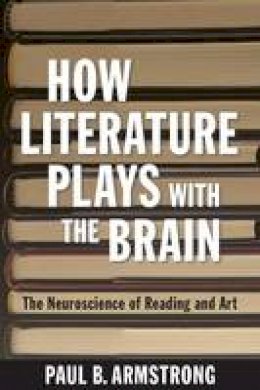
Stock image for illustration purposes only - book cover, edition or condition may vary.
How Literature Plays with the Brain: The Neuroscience of Reading and Art
Paul B. Armstrong
€ 45.08
FREE Delivery in Ireland
Description for How Literature Plays with the Brain: The Neuroscience of Reading and Art
Paperback. Examines the parallels between certain features of literary experience and functions of the brain. For the neuroscientific community, this book suggests that different areas of research - the neurobiology of vision and reading, the brain-body interactions underlying emotions - may be connected to a variety of aesthetic and literary phenomena. Num Pages: 240 pages, 23, 23 black & white illustrations. BIC Classification: DSA; GTR; PSAN. Category: (P) Professional & Vocational. Dimension: 155 x 229 x 16. Weight in Grams: 344.
Literature matters, says Paul B. Armstrong, for what it reveals about human experience, and the very different perspective of neuroscience on how the brain works is part of that story. In How Literature Plays with the Brain, Armstrong examines the parallels between certain features of literary experience and functions of the brain. His central argument is that literature plays with the brain through experiences of harmony and dissonance which set in motion oppositions that are fundamental to the neurobiology of mental functioning. These oppositions negotiate basic tensions in the operation of the brain between the drive for pattern, synthesis, and constancy and the need for flexibility, adaptability, and openness to change. The challenge, Armstrong argues, is to account for the ability of readers to find incommensurable meanings in the same text, for example, or to take pleasure in art that is harmonious or dissonant, symmetrical or distorted, unified or discontinuous and disruptive. How Literature Plays with the Brain is the first book to use the resources of neuroscience and phenomenology to analyze aesthetic experience. For the neuroscientific community, the study suggests that different areas of research-the neurobiology of vision and reading, the brain-body interactions underlying emotions-may be connected to a variety of aesthetic and literary phenomena. For critics and students of literature, the study engages fundamental questions within the humanities: What is aesthetic experience? What happens when we read a literary work? How does the interpretation of literature relate to other ways of knowing?
Product Details
Publisher
Johns Hopkins University Press
Format
Paperback
Publication date
2014
Condition
New
Weight
343g
Number of Pages
240
Place of Publication
Baltimore, MD, United States
ISBN
9781421415765
SKU
V9781421415765
Shipping Time
Usually ships in 7 to 11 working days
Ref
99-1
About Paul B. Armstrong
Paul B. Armstrong is a professor of English at Brown University. He is the author of several books, including Conflicting Readings: Variety and Validity in Interpretation and Play and the Politics of Reading: The Social Uses of Modernist Form.
Reviews for How Literature Plays with the Brain: The Neuroscience of Reading and Art
Armstrong's book is a testament to the value of the arts and the humanities since their processes and productions generate ideas that are literally the physical (neurobiological) stuff of which we are made.
Gregory F. Tague
ASEBL Journal
How Literature Plays with the Brain: The Neuroscience of Reading and Art is a highly informative and carefully argued book. We recommend a close reading of it.
Linguistic and Philosophical Investigations
Armstrong's book is a beautiful example of how humanities scholars can accomplish a conversation across the gap between the 'two cultures' without giving up their disciplinary identity, bringing the larger picture to bear on the more particular research of the cognitive sciences.
Karin Kukkonen
Cambridge Quarterly
Armstrong finds his inspiration in recent neuroscience... his overview of mirror neuron theory and the controversies that surround it, for example, outdoes in accuracy and judiciousness any other account I have seen among neuroaesthetics and cognitive literary studies.
Modern Fiction Studies
At present, when so many universities would gleefully discard the study of the arts in the service of a utilitarian turn in higher education, the evidence that Armstrong provides for their vital cognitive function and the coherence with which he presents that evidence is indeed both welcome and timely.
Philosophy and Literature
Gregory F. Tague
ASEBL Journal
How Literature Plays with the Brain: The Neuroscience of Reading and Art is a highly informative and carefully argued book. We recommend a close reading of it.
Linguistic and Philosophical Investigations
Armstrong's book is a beautiful example of how humanities scholars can accomplish a conversation across the gap between the 'two cultures' without giving up their disciplinary identity, bringing the larger picture to bear on the more particular research of the cognitive sciences.
Karin Kukkonen
Cambridge Quarterly
Armstrong finds his inspiration in recent neuroscience... his overview of mirror neuron theory and the controversies that surround it, for example, outdoes in accuracy and judiciousness any other account I have seen among neuroaesthetics and cognitive literary studies.
Modern Fiction Studies
At present, when so many universities would gleefully discard the study of the arts in the service of a utilitarian turn in higher education, the evidence that Armstrong provides for their vital cognitive function and the coherence with which he presents that evidence is indeed both welcome and timely.
Philosophy and Literature
